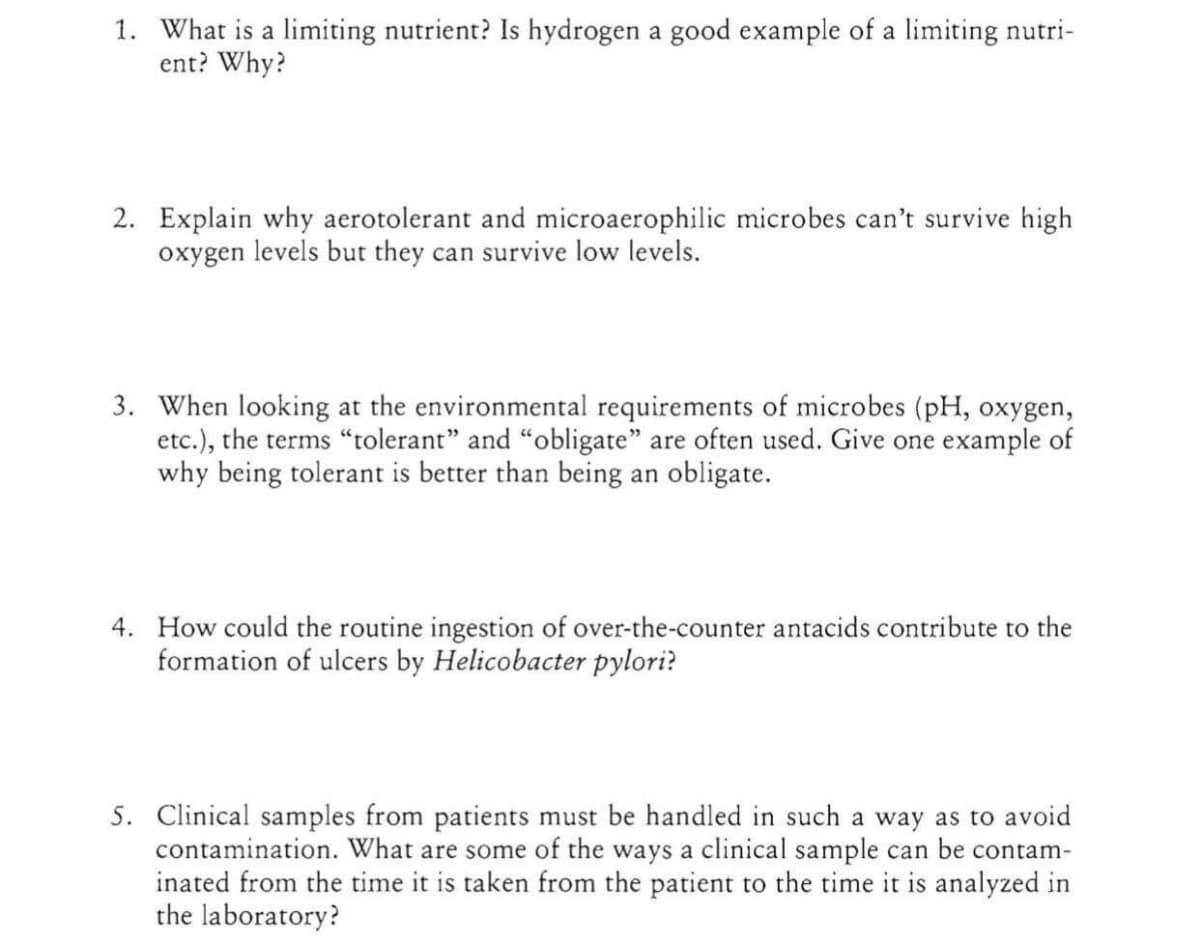Biology 2e
2nd Edition
ISBN:9781947172517
Author:Matthew Douglas, Jung Choi, Mary Ann Clark
Publisher:Matthew Douglas, Jung Choi, Mary Ann Clark
Chapter4: Cell Structure
Section: Chapter Questions
Problem 13RQ: Tay-Sachs disease is a genetic disorder that results in the destruction of neurons due to a buildup...
Related questions
Question
Please help, thank you so much in advance!

Transcribed Image Text:1. What is a limiting nutrient? Is hydrogen a good example of a limiting nutri-
ent? Why?
2. Explain why aerotolerant and microaerophilic microbes can't survive high
oxygen levels but they can survive low levels.
3. When looking at the environmental requirements of microbes (pH, oxygen,
etc.), the terms "tolerant" and "obligate" are often used. Give one example of
why being tolerant is better than being an obligate.
4. How could the routine ingestion of over-the-counter antacids contribute to the
formation of ulcers by Helicobacter pylori?
5. Clinical samples from patients must be handled in such a way as to avoid
contamination. What are some of the ways a clinical sample can be contam-
inated from the time it is taken from the patient to the time it is analyzed in
the laboratory?

Transcribed Image Text:Critical Thinking
1. There is a very large difference between the amount of carbon comprising a
prokaryotic cell (50%) and the amount of iron (0.25%). Both elements are nec-
essary to the cell and the cell would die without either. Why, then, is there such
a disparity in how much of each is needed? (Hint: Think of what the ele-
ments are used for when composing your answer.)
2. Which type of microbe, a single-celled microbe or a multicellular microbe,
will have the broader temperature range over which it can survive? Why?
3. Where might you expect to find a fastidious microorganism living?
Expert Solution
This question has been solved!
Explore an expertly crafted, step-by-step solution for a thorough understanding of key concepts.
Step by step
Solved in 2 steps

Knowledge Booster
Learn more about
Need a deep-dive on the concept behind this application? Look no further. Learn more about this topic, biology and related others by exploring similar questions and additional content below.Recommended textbooks for you

Biology 2e
Biology
ISBN:
9781947172517
Author:
Matthew Douglas, Jung Choi, Mary Ann Clark
Publisher:
OpenStax

Biology: The Unity and Diversity of Life (MindTap…
Biology
ISBN:
9781337408332
Author:
Cecie Starr, Ralph Taggart, Christine Evers, Lisa Starr
Publisher:
Cengage Learning

Biology 2e
Biology
ISBN:
9781947172517
Author:
Matthew Douglas, Jung Choi, Mary Ann Clark
Publisher:
OpenStax

Biology: The Unity and Diversity of Life (MindTap…
Biology
ISBN:
9781337408332
Author:
Cecie Starr, Ralph Taggart, Christine Evers, Lisa Starr
Publisher:
Cengage Learning